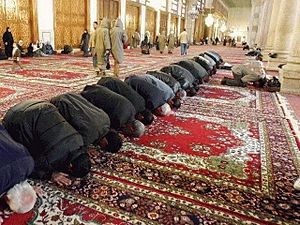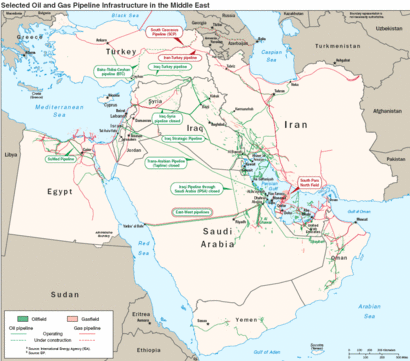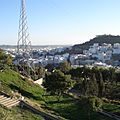Middle East facts for kids
The Middle East is an area of land and group of countries in Southwest Asia and North Africa. Today, people usually call these countries "Middle Eastern" since they are in the Eastern Mediterranean or west of Central Asia.
Sometimes, people also include these countries as part of a Greater Middle East: Algeria, Morocco and Tunisia in North Africa, the Pakistan and the countries Afghanistan and Kazakhstan, Kyrgyzstan, Tajikistan, Turkmenistan, and Uzbekistan in South-central Asia.
Ancient civilizations began in the Fertile Crescent in the Middle East. These were Sumer, Babylonia and Assyria in the area called Mesopotamia, and Ancient Egypt. The three Abrahamic religions that believe in one God also came from the Middle East. Judaism and Christianity began in ancient Israel and Islam began in Arabia.
Today, the Middle East is very important because a lot of the petroleum that other countries need comes from here. There are also many arguments and fights here, such as the Sunni-Shia conflict, the Israeli-Palestinian conflict and the Syrian civil war.
Contents
Demographics
Ethnic groups
Arabs constitute the largest ethnic group in the Middle East, followed by Turkic people. Native ethnic groups of the region include, in addition to Arabs, Arameans, Assyrians, Baloch, Berbers, Copts, Druze, Jews, Kurds, Lurs, Mandaeans, Persians, Samaritans, Shabaks, Tats, and Zazas.
Migration
"Migration has always provided an important vent for labor market pressures in the Middle East. For the period between the 1970s and 1990s, the Arab states of the PersianGulf in particular provided a rich source of employment for workers from Egypt, Yemen and the countries of the Levant, while Europe had attracted young workers from North African countries due both to proximity and the legacy of colonial ties between Franceand the majority of North African states." According to the International Organization for Migration, there are 13 million first-generation migrants from Arab nations in the world, of which 5.8 reside in other Arab countries. Expatriates from Arab countries contribute to the circulation of financial and human capital in the region and thus significantly promote regional development. In 2009 Arab countries received a total of 35.1 billion USD in remittance in-flows and remittances sent to Jordan, Egypt and Lebanon from other Arab countries are 40 to 190 per cent higher than trade revenues between these and other Arab countries. In Somalia, the Somali Civil War has greatly increased the size of the Somali diaspora, as many of the best educated Somalis left for Middle Eastern countries as well as Europe and North America.
Non-Arab Middle Eastern countries such as Turkey, Israel and Iran are also subject to important migration dynamics.
A fair proportion of those migrating from Arab nations are from ethnic and religious minorities facing racial and or religious persecution and are not necessarily ethnic Arabs, Iranians or Turks. Large numbers of Kurds, Jews, Assyrians, Greeks and Armenians as well as many Mandeans have left nations such as Iraq, Iran, Syria and Turkey for these reasons during the last century. In Iran, many religious minorities such as Christians, Baha'is and Zoroastrians have left since the Islamic Revolution of 1979.
Religions
The Middle East is very diverse when it comes to religions, many of which originated there. Islam is the largest religion in the Middle East, but other faiths that originated there, such as Judaism and Christianity, are also well represented. Christians represent 40.5% of Lebanon, where the Lebanese president, half of the cabinet, and half of the parliament follow one of the various Lebanese Christian rites. There are also important minority religions like the Bahá'í Faith, Yarsanism, Yazidism, Zoroastrianism, Mandaeism, Druze, and Shabakism, and in ancient times the region was home to Mesopotamian religions, Canaanite religions, Manichaeism, Mithraism and various monotheist gnostic sects.
Languages
The five top languages, in terms of numbers of speakers, are Arabic, Persian, Turkish, Kurdish, and Hebrew. Arabic and Hebrew represent the Afro-Asiatic language family. Persian and Kurdish belong to the Indo-European language family. Turkish belongs to Turkic language family. About 20 minority languages are also spoken in the Middle East.
Arabic, with all its dialects, are the most widely spoken languages in the Middle East, with Literary Arabic being official in all North African and in most West Asian countries. Arabic dialects are also spoken in some adjacent areas in neighbouring Middle Eastern non-Arab countries. It is a member of the Semitic branch of the Afro-Asiatic languages. Several Modern South Arabian languages such as Mehri and Soqotri are also spoken Yemen and Oman. Another Semitic language such as Aramaic and its dialects are spoken mainly by Assyrians and Mandaeans. There is also a Oasis Berber-speaking community in Egypt where the language is also known as Siwa. It is a non-Semitic Afro-Asiatic language.
Persian is the second most spoken language. While it is primarily spoken in Iran and some border areas in neighbouring countries, the country is one of the region's largest and most populous. It belongs to the Indo-Iranian branch of the family of Indo-European languages. Other Western Iranic languages spoken in the region include Achomi, Daylami, Kurdish dialects, Semmani, Lurish, amongst many others.
The third-most widely spoken language, Turkish, is largely confined to Turkey, which is also one of the region's largest and most populous countries, but it is present in areas in neighboring countries. It is a member of the Turkic languages, which have their origins in Central Asia. Another Turkic language, Azerbaijani, is spoken by Azerbaijanis in Iran.
Hebrew is one of the two official languages of Israel, the other being Arabic. Hebrew is spoken and used by over 80% of Israel's population, the other 20% using Arabic.
English is commonly taught and used as a second language, especially among the middle and upper classes, in countries such as Egypt, Jordan, Iran, Kurdistan, Iraq, Qatar, Bahrain, United Arab Emirates and Kuwait. It is also a main language in some Emirates of the United Arab Emirates.
French is taught and used in many government facilities and media in Lebanon, and is taught in some primary and secondary schools of Egypt and Syria. Maltese, a Semitic language mainly spoken in Europe, is also used by the Franco-Maltese diaspora in Egypt.
Armenian and Greek speakers are also to be found in the region. Georgian is spoken by the Georgian diaspora. Russian is spoken by a large portion of the Israeli population, because of emigration in the late 1990s. Russian today is a popular unofficial language in use in Israel; news, radio and sign boards can be found in Russian around the country after Hebrew and Arabic. Circassian is also spoken by the diaspora in the region and by almost all Circassians in Israel who speak Hebrew and English as well. The largest Romanian-speaking community in the Middle East is found in Israel, where as of 1995[update] Romanian is spoken by 5% of the population.
Bengali, Hindi and Urdu is widely spoken by migrant communities in many Middle Eastern countries, such as Saudi Arabia (where 20–25% of the population is South Asian), the United Arab Emirates (where 50–55% of the population is South Asian), and Qatar, which have large numbers of Pakistani, Bangladeshi and Indian immigrants.
Economy
The economic structure of Middle Eastern nations are different in the sense that while some nations are heavily dependent on export of only oil and oil-related products (such as Saudi Arabia, the UAE and Kuwait), others have a highly diverse economic base (such as Cyprus, Israel, Turkey and Egypt). Industries of the Middle Eastern region include oil and oil-related products, agriculture, cotton, cattle, dairy, textiles, leather products, surgical instruments, defence equipment (guns, ammunition, tanks, submarines, fighter jets, UAVs, and missiles). Banking is also an important sector of the economies, especially in the case of UAE and Bahrain.
With the exception of Cyprus, Turkey, Egypt, Lebanon and Israel, tourism has been a relatively undeveloped area of the economy, in part because of the socially conservative nature of the region as well as political turmoil in certain regions of the Middle East. In recent years, however, countries such as the UAE, Bahrain, and Jordan have begun attracting greater number of tourists because of improving tourist facilities and the relaxing of tourism-related restrictive policies.
Related pages
Gallery
-
Abu Dhabi - UAE
-
Amman - Jordan
-
Ankara - Turkey
-
Baghdad - Iraq
-
Beirut - Lebanon
-
Cairo - Egypt
-
Damascus - Syria
-
Doha - Qatar
-
Dubai - UAE
-
Istanbul - Turkey
-
Jerusalem - Israel
-
Kuwait City - Kuwait
-
Manama - Bahrain
-
Mecca - Saudi Arabia
-
Muscat, Oman
-
Nicosia , Cyprus
-
Ramallah - Palestine
-
Sana'a - Yemen
-
Tabriz - Iran
-
Tehran - Iran
-
Tel Aviv - Israel
Images for kids
-
Some henges at Göbekli Tepe were erected as far back as 9600 BC, predating those of Stonehenge, England, by over seven millennia. The site of the oldest known man-made religious structure.
-
Church of the Holy Sepulchre in Jerusalem
-
The Kaaba, located in Mecca, Saudi Arabia
-
Abu Dhabi – United Arab Emirates
-
Amman – Jordan
-
Ankara – Turkey
-
Beirut – Lebanon
-
Cairo – Egypt
-
Damascus – Syria
-
Doha – Qatar
-
Dubai – United Arab Emirates
-
Istanbul – Turkey
-
Jerusalem – Israel
-
Manama – Bahrain
-
Muscat – Oman
-
Ramallah – Palestine
-
Sana'a – Yemen
-
Tehran – Iran
-
Tel Aviv – Israel
See also
 In Spanish: Oriente Medio para niños
In Spanish: Oriente Medio para niños
















































